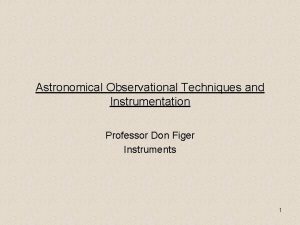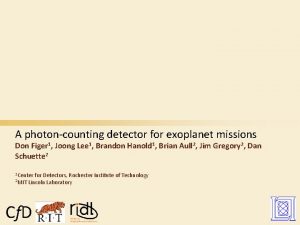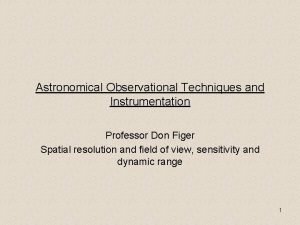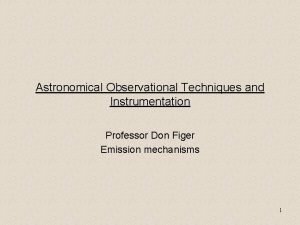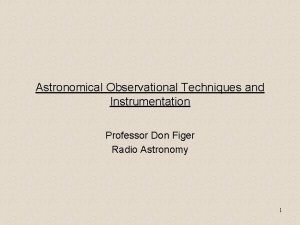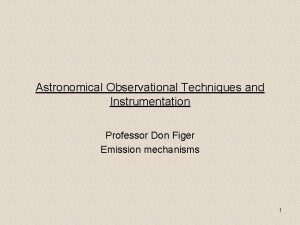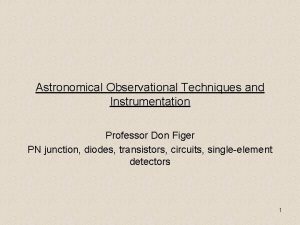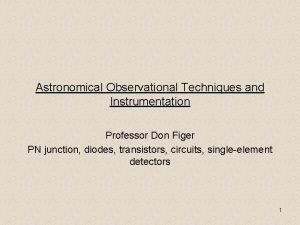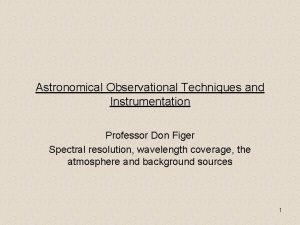UNIVERSITY ASTRONOMY Professor Don Figer Motion of the















































- Slides: 47

UNIVERSITY ASTRONOMY Professor Don Figer Motion of the Sky 1

Aims and outline for this lecture ■ explore how objects move in the sky – sun – stars – ecliptic – zodiac – planets – retrograde and prograde motion ■ review laws of motion for orbital bodies 2

MOTION ON THE SKY

Question ■ In what direction would you face to see Star A when it is highest in the sky? ■ a) north ■ b) south ■ c) east ■ d) west ■ e) directly overhead ■ vote! 4

Answer ■ In what direction would you face to see Star A when it is highest in the sky? ■ a) north ■ b) south ■ c) east ■ d) west ■ e) directly overhead 5

Question ■ What is the altitude of a star that rises due East when it is highest in the sky? ■ a) the latitude ■ b) 45 degrees minus lat ■ c) 90 degrees minus lat ■ d) the declination ■ vote! 6

Answer ■ What is the altitude of a star that rises due East when it is highest in the sky? ■ a) the latitude ■ b) 45 degrees minus lat ■ c) 90 degrees minus lat ■ d) the declination 7

Question ■ What is the azimuth of the star indicated by the arrow? ■ a) 135 degrees ■ b) 45 degrees ■ c) the longitude ■ d) RA minus 45 degrees ■ vote! 8

Answer ■ What is the azimuth of the star indicated by the arrow? ■ a) 135 degrees ■ b) 45 degrees ■ c) the longitude ■ d) RA minus 45 degrees 9

Question ■ At what time will Star B be highest in the sky (see picture on next slide)? ■ a) morning ■ b) noon ■ c) afternoon ■ d) midnight ■ vote! 10

Question 11

Answer ■ ■ ■ At what time will Star B be highest in the sky? a) morning b) noon c) afternoon d) midnight 12

Ecliptic Plane ■ The ecliptic plane is defined by a circle through which the Sun appears to travel in the sky over the course of a year. ■ The plane is tilted by 23. 5 degrees with respect to the Earth’s orbital plane. 13

Ecliptic Plane and Zodiac ■ The constellations along the ecliptic make up the zodiac. ■ Your “sign” is the constellation behind the Sun when you were born. ■ Today’s zodiac is off by roughly one constellation, due to precession of the equinoxes. 14

Precession of the Equinoxes ■ The NCP traces a circle in the sky once every 26, 000 years. ■ NCP is near Polaris. ■ In 12, 000 years, it will point near Vega. ■ Positions of equinoxes shift. 15

Precession Caused by Gravity 16

Ecliptic Plane and Solar System Bodies ■ Most objects in the Solar System appear to travel along the ecliptic plane because those objects orbit in roughly the same plane. ■ This is why other planets appear in constellations of the Zodiac. 17

Ecliptic Plane and Equinoxes ■ The ecliptic and celestial equator cross at two points called “equinoxes. ” ■ The word equinox means equal time for day and night. ■ Autumnal equinox ~ Sep 20. ■ Vernal equinox ~ Mar 20 ■ Other points are solstices. ■ The word solstice means the point when “sol” is highest and lowest. 18

Sun’s Path in Sky ■ Daytime is longer in summers. ■ Daytime and nighttime are equal on equinoxes. ■ The sun reaches its lowest height in the sky on winter solstice. ■ The variation of maximum height for the sun is greater for locations toward the Earth’s poles. 19

Question ■ At what latitude will sun no longer set during summer? ■ a) 23. 5 degrees ■ b) 0 degrees ■ c) 90 degrees ■ d) 66. 5 degrees ■ vote! 20

Answer ■ At what latitude will sun no longer set during summer? ■ a) 23. 5 degrees ■ b) 0 degrees ■ c) 90 degrees ■ d) 66. 5 degrees 21

Seasons ■ Seasons occur because temperature varies. ■ Temperature is related to the amount of solar flux absorbed by the Earth. ■ This is a maximum during the summer. 22

Question ■ ■ ■ Why is it cold in January in northern latitudes? a) Earth is farthest from sun b) sun is lower in the sky c) the orbital velocity of the Earth is highest d) that is ski season ■ vote! 23

Answer ■ ■ ■ Why is it cold in January in northern latitudes? a) Earth is farthest from sun b) sun is lower in the sky (less areal flux) c) the orbital velocity of the Earth is highest d) that is ski season 24

MOTION OF PLANETS IN THE SKY

Time ■ Earth revolves around sun and rotates around axis. – rotation results in diurnal motion of stars – revolution results in sun’s apparent motion relative to stars ■ Solar day is time between meridian crossings of sun. ■ Sidereal day is time between meridian crossings of stars. 26

Local Sidereal Time ■ Local Sidereal Time (LST) is the RA of an object on the meridian. ■ Hour Angle (HA) is the angle in the direction of right ascension between an object and the meridian. HAobj=LST -RAobj 27

Motions of Objects in Sky ■ The Sun moves eastward relative to the stars by about one degree per day. ■ The stars rise earlier by about four minutes each night, giving rise to “seasonal” constellations. For example, Orion is a winter constellation in the north. ■ The Moon moves eastward relative to the stars by about 13 degrees per day, traversing 360 degrees in about 27. 5 days. It moves about 12 degrees relative to the Sun, so it takes approximately 29. 5 days to complete a set of phases (synodic, or lunar, month). ■ The planets move relative to stars because of their orbital motion and Earth’s orbital motion. Can induce “retrograde” motion. 28

Prograde and Retrograde Motion ■ During a night, planets move from east to west, just like the stars. ■ From night to night, the planets move relative to the stars. ■ Usually, they move west to east relative to the stars (prograde). ■ Sometimes, they move east to west (retrograde). 29

Retrograde Motion of Mars 30

Conjunction and Opposition 31

Conjunction and Opposition 32

Sidereal Period ■ The sidereal period is the time it takes for an object to orbit another with respect to the fixed coordinate system of the stars. ■ So, for Earth, the sidereal period is 365. 25636 days. ■ Our calendar only has 365 days in it, so we add a day every leap year. 33

Synodic Period 34

Kepler’s Laws of Orbital Motion ■ 1 st Law: planets travel on elliptical orbits with the Sun at one focus. ■ 2 nd Law: A line drawn from the Sun to a planet sweeps out equal areas in equal time intervals. ■ 3 rd Law: The squares of the sidereal orbital periods of the planets are proportional to the cubes of the semimajor axis of their orbits. 35

Keplerian Model ■ Kepler realized that orbits are elliptical (1 st law). ■ Planets sweep equal areas in equal time (2 nd law). ■ The square of the orbital period is proportional to the cube of the distance to the Sun (3 rd law). 36

Kepler’s 2 nd Law 37

Kepler’s 2 nd Law 38

Kepler’s 3 rd Law (P 2µa 3) 39

DISTANCES AND ANGLES

Heliocentric Parallax ■ Parallax is the apparent shift of an object due to viewpoint. ■ As an example, watch your thumb shift with respect to objects far away as you view it from each eye. ■ The angular shift depends on distance. ■ We can use this effect to estimate distance to nearby stars by viewing them when the Earth is on opposite sides of the Sun. 41

Distance vs. Parallax 42

Parsec ■ A parsec is the distance at which an object has one arcsecond of parallax. “Parallax of one arcsec” ■ The star nearest to the sun, Proxima Centauri, has a parallax of 0. 76 arcseconds. What is its distance? 43

HOMEWORK

Homework ■ 2. 1, 2. 3, 2. 5, 2. 6 (consider equations 2. 17 and 2. 8) 1. What is the name of the part of the eye that limits the amount of light that enters it? 2. Consider a photon with vacuum wavelength of 550 nm. What is its energy in a typical glass? 3. In which wavelength regime is the atmosphere most transparent? 4. Use the Wien displacement law to calculate the wavelength for which the cosmic microwave background is at a peak, assuming that it is represented by a blackbody with T=2. 7 K. 45

Homework 46

Homework 47
 Don figer
Don figer Heilmeier catechism
Heilmeier catechism Figer definition
Figer definition Don figer
Don figer Learning astronomy by doing astronomy activity 1 answers
Learning astronomy by doing astronomy activity 1 answers Learning astronomy by doing astronomy activity 7 answers
Learning astronomy by doing astronomy activity 7 answers Learning astronomy by doing astronomy activity 1 answers
Learning astronomy by doing astronomy activity 1 answers Figer counting
Figer counting Promotion from associate professor to professor
Promotion from associate professor to professor Michigan state university physics department
Michigan state university physics department Taking things without asking
Taking things without asking Leonardo sarao picture
Leonardo sarao picture Range of motion types
Range of motion types Simple harmonic motion formula
Simple harmonic motion formula An object in motion stays in motion
An object in motion stays in motion Chapter 2 motion section 1 describing motion answer key
Chapter 2 motion section 1 describing motion answer key The main difference between speed and velocity involves
The main difference between speed and velocity involves Section 1 describing motion
Section 1 describing motion Chapter 11 section 1 measuring motion answer key
Chapter 11 section 1 measuring motion answer key Section 1 describing motion
Section 1 describing motion Hát kết hợp bộ gõ cơ thể
Hát kết hợp bộ gõ cơ thể Lp html
Lp html Bổ thể
Bổ thể Tỉ lệ cơ thể trẻ em
Tỉ lệ cơ thể trẻ em Gấu đi như thế nào
Gấu đi như thế nào Thang điểm glasgow
Thang điểm glasgow Chúa yêu trần thế alleluia
Chúa yêu trần thế alleluia Môn thể thao bắt đầu bằng chữ f
Môn thể thao bắt đầu bằng chữ f Thế nào là hệ số cao nhất
Thế nào là hệ số cao nhất Các châu lục và đại dương trên thế giới
Các châu lục và đại dương trên thế giới Cong thức tính động năng
Cong thức tính động năng Trời xanh đây là của chúng ta thể thơ
Trời xanh đây là của chúng ta thể thơ Cách giải mật thư tọa độ
Cách giải mật thư tọa độ Làm thế nào để 102-1=99
Làm thế nào để 102-1=99 độ dài liên kết
độ dài liên kết Các châu lục và đại dương trên thế giới
Các châu lục và đại dương trên thế giới Thể thơ truyền thống
Thể thơ truyền thống Quá trình desamine hóa có thể tạo ra
Quá trình desamine hóa có thể tạo ra Một số thể thơ truyền thống
Một số thể thơ truyền thống Cái miệng xinh xinh thế chỉ nói điều hay thôi
Cái miệng xinh xinh thế chỉ nói điều hay thôi Vẽ hình chiếu vuông góc của vật thể sau
Vẽ hình chiếu vuông góc của vật thể sau Biện pháp chống mỏi cơ
Biện pháp chống mỏi cơ đặc điểm cơ thể của người tối cổ
đặc điểm cơ thể của người tối cổ Thứ tự các dấu thăng giáng ở hóa biểu
Thứ tự các dấu thăng giáng ở hóa biểu Vẽ hình chiếu đứng bằng cạnh của vật thể
Vẽ hình chiếu đứng bằng cạnh của vật thể Tia chieu sa te
Tia chieu sa te Thẻ vin
Thẻ vin đại từ thay thế
đại từ thay thế



